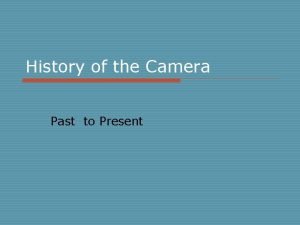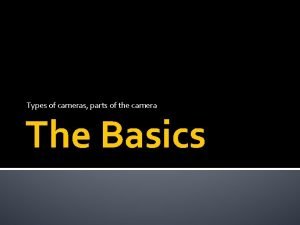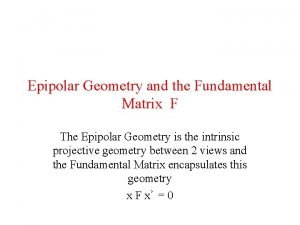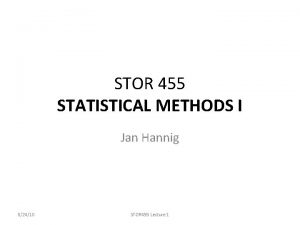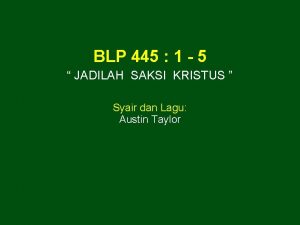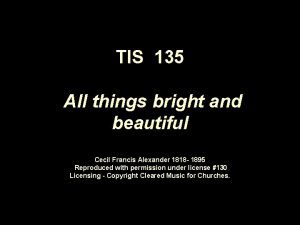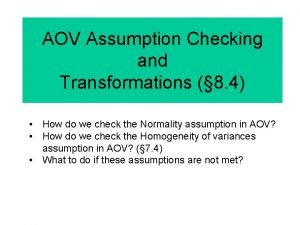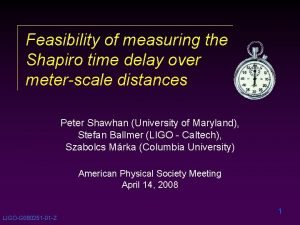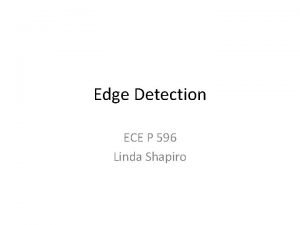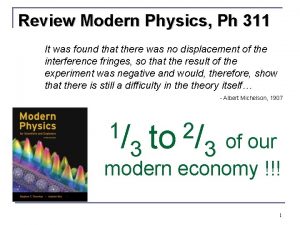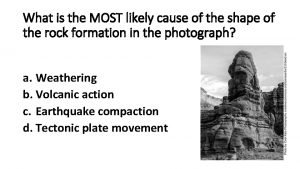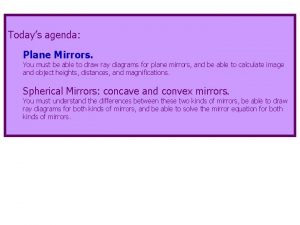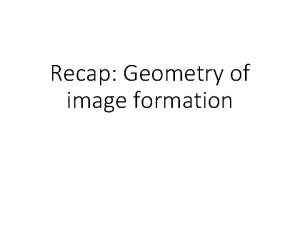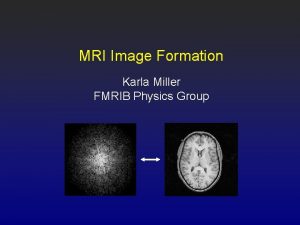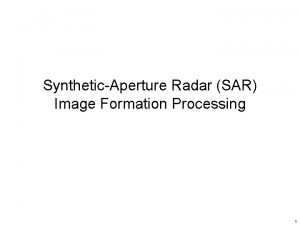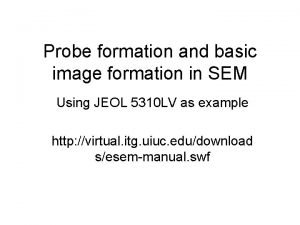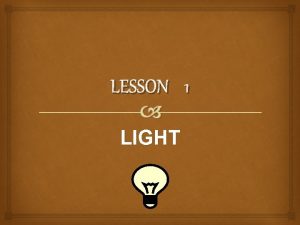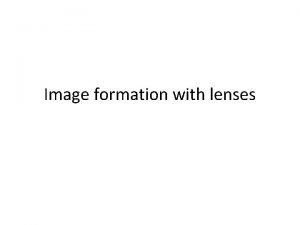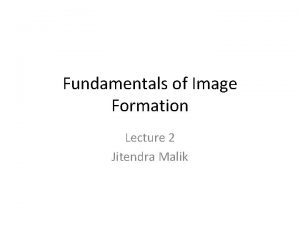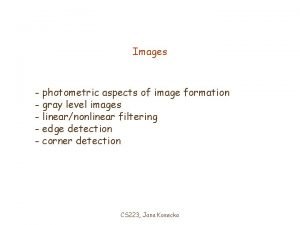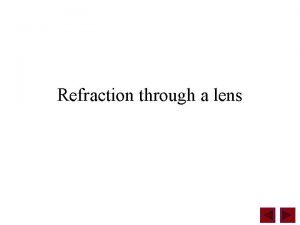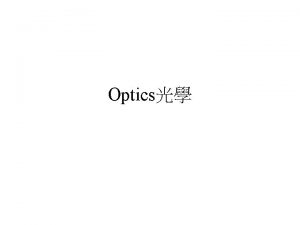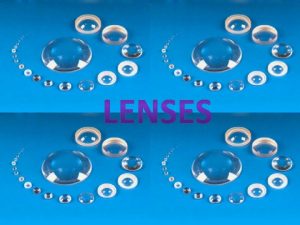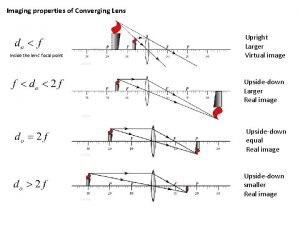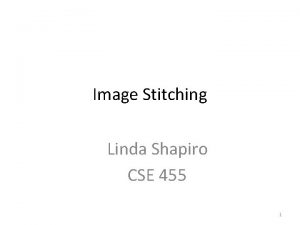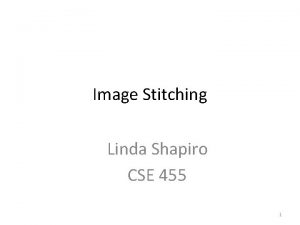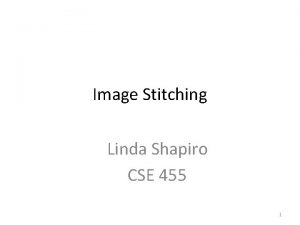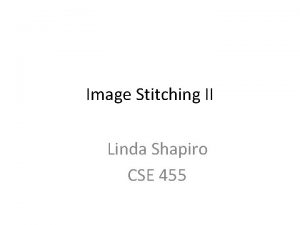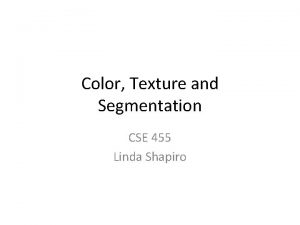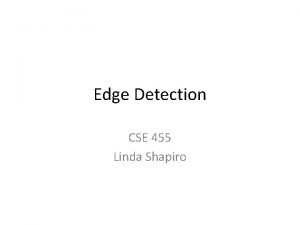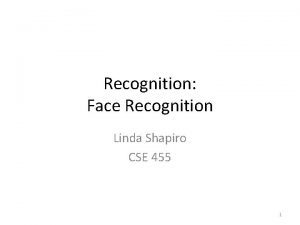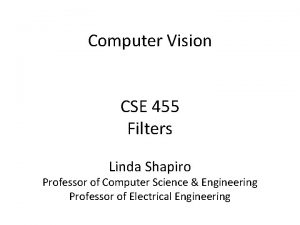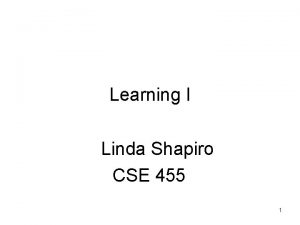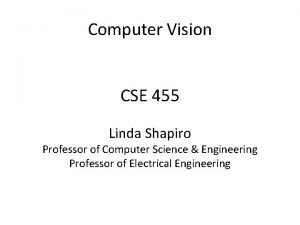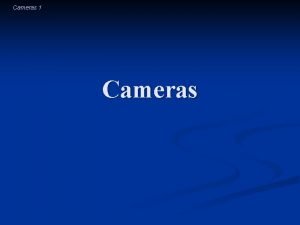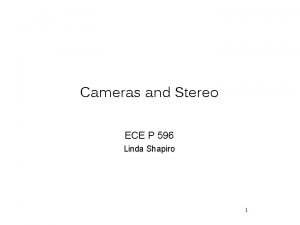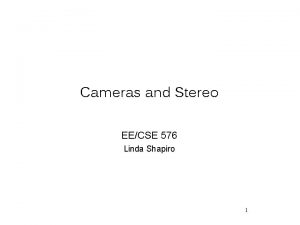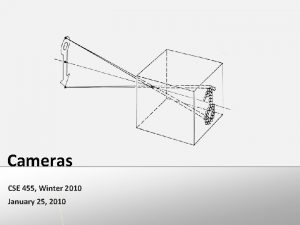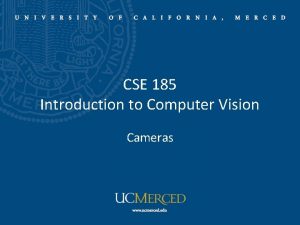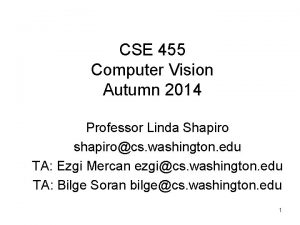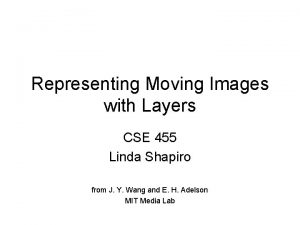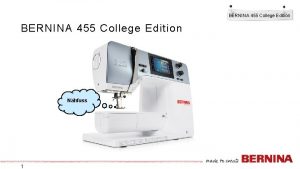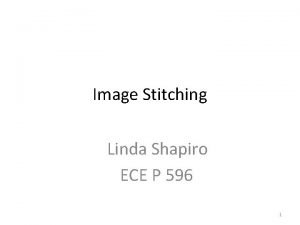Image Formation and Cameras CSE 455 Linda Shapiro
































































- Slides: 64

Image Formation and Cameras CSE 455 Linda Shapiro 1

Projection http: //www. julianbeever. net/pave. htm • Do sizes, lengths seem accurate? • How do you know? 2

Projection http: //www. julianbeever. net/pave. htm • What’s wrong? • Why do you think it’s wrong? 3

Müller-Lyer Illusion http: //www. michaelbach. de/ot/sze_muelue/index. html • What do you know about perspective projection? • Vertical lines? • Other lines? 4

Image formation Object Film Let’s design a camera • Idea 1: put a piece of film in front of an object • Do we get a reasonable image? 5

Pinhole camera Object Barrier Film Add a barrier to block off most of the rays • This reduces blurring • The opening known as the aperture • How does this transform the image? 6

Camera Obscura Gemma Frisius, 1558 • Basic principle known to Mozi (470 -390 BC), Aristotle (384 -322 BC) • Drawing aid for artists: described by Leonardo da Vinci (1452 -1519) 7

Camera Obscura The first camera • How does the aperture size affect the image? 8

Shrinking the aperture Why not make the aperture as small as possible? • Less light gets through • Diffraction effects. . . 9

Diffraction • Light rays passing through a small aperture will begin to diverge and interfere with one another. • This becomes more significant as the size of the aperture decreases relative to the wavelength of light passing through. • This effect is normally negligible, since smaller apertures often improve sharpness. • But at some point, your camera becomes diffraction 10 limited, and the quality goes down.

Shrinking the aperture 11

Pinhole Cameras: Total Eclipse • A total eclipse occurs when the moon comes between the earth and the sun, obscuring the sun. 12

Pinhole cameras everywhere Sun “shadows” during a solar eclipse by Henrik von Wendt http: //www. flickr. com/photos/hvw/2724969199/ The holes between fingers work like a camera obscura and 13 show the eclipsed sun

Pinhole cameras everywhere Sun “shadows” during a partial solar eclipse http: //www. flickr. com/photos/73860948@N 08/6678331997/ 14

Pinhole cameras everywhere Tree shadow during a solar eclipse photo credit: Nils van der Burg http: //www. physicstogo. org/index. cfm 15

Adding a lens “circle of confusion” A lens focuses light onto the film • There is a specific distance at which objects are “in focus” – other points project to a “circle of confusion” in the image • Changing the shape of the lens changes this distance 16

Lenses F focal point optical center (Center Of Projection) A lens focuses parallel rays onto a single focal point • focal point at a distance f beyond the plane of the lens – f is a function of the shape and index of refraction of the lens • Aperture of diameter D restricts the range of rays – aperture may be on either side of the lens • Lenses are typically spherical (easier to produce) 17 • Real cameras use many lenses together (to correct for aberrations)

Thin lenses Thin lens equation: • Any object point satisfying this equation is in focus 18

Thin lens assumption The thin lens assumption assumes the lens has no thickness, but this isn’t true… Object Film Lens Focal point By adding more elements to the lens, the distance at which a scene is in focus can be made roughly planar. 19

Depth of field Aperture Film f / 5. 6 f / 32 Changing the aperture size affects depth of field • A smaller aperture increases the range in which the object is approximately in focus Flower images from Wikipedia 20 http: //en. wikipedia. org/wiki/Depth_of_field

The eye The human eye is a camera • Iris - colored annulus with radial muscles • Pupil - the hole (aperture) whose size is controlled by the iris • What’s the “film”? – photoreceptor cells (rods and cones) in the retina • How do we refocus? – Change the shape of the lens 21

Digital camera A digital camera replaces film with a sensor array • Each cell in the array is a Charge Coupled Device (CCD) – light-sensitive diode that converts photons to electrons • CMOS is becoming more popular (esp. in cell phones) – http: //electronics. howstuffworks. com/digital-camera. htm 22

Issues with digital cameras Noise – big difference between consumer vs. SLR-style cameras – low light is where you most notice noise Compression – creates artifacts except in uncompressed formats (tiff, raw) Color – color fringing artifacts from Bayer patterns Blooming – charge overflowing into neighboring pixels In-camera processing – oversharpening can produce halos Interlaced vs. progressive scan video – even/odd rows from different exposures Are more megapixels better? – requires higher quality lens – noise issues Stabilization – compensate for camera shake (mechanical vs. electronic) More info online, e. g. , • http: //electronics. howstuffworks. com/digital-camera. htm • http: //www. dpreview. com/ 23

Projection Mapping from the world (3 d) to an image (2 d) • Can we have a 1 -to-1 mapping? • How many possible mappings are there? An optical system defines a particular projection. We’ll talk about 2: 1. Perspective projection (how we see “normally”) 2. Orthographic projection (e. g. , telephoto lenses) 24

Modeling projection 3 D point negative z axis The coordinate system • • We will use the pin-hole model as an approximation Put the optical center (Center Of Projection) at the origin Put the image plane (Projection Plane) in front of the COP The camera looks down the negative z axis – we need this if we want right-handed-coordinates 25

Modeling projection Projection equations • Compute intersection with PP of ray from (x, y, z) to COP • Derived using similar triangles • We get the projection by throwing out the last coordinate: 26

Homogeneous coordinates Is this a linear transformation? • no—division by z is nonlinear Trick: add one more coordinate: homogeneous image coordinates homogeneous scene coordinates Converting from homogeneous coordinates 27

Perspective Projection is a matrix multiply using homogeneous coordinates: projection matrix 3 D point divide by third coordinate 2 D point This is known as perspective projection • The matrix is the projection matrix 28

Perspective Projection Example 1. Object point at (10, 6, 4), d=2 2. Object point at (25, 10) Perspective projection is not 1 -to-1! 29

Perspective Projection How does scaling the projection matrix change the transformation? 30

Perspective Projection • What happens to parallel lines? • What happens to angles? • What happens to distances? 31

Perspective Projection What happens when d ? 32

Orthographic projection Special case of perspective projection • Distance from the COP to the PP is infinite Image World • Good approximation for telephoto optics • Also called “parallel projection”: (x, y, z) → (x, y) • What’s the projection matrix? 33

Orthographic (“telecentric”) lenses Navitar telecentric zoom lens http: //www. lhup. edu/~dsimanek/3 d/telecent. htm 34

Orthographic Projection • What happens to parallel lines? • What happens to angles? • What happens to distances? 35

Camera parameters How many numbers do we need to describe a camera? • We need to describe its pose in the world • We need to describe its internal parameters 36

A Tale of Two Coordinate Systems v COP w Camera y u Two important coordinate systems: 1. World coordinate system 2. Camera coordinate system x o z “The World” 37

Camera parameters • To project a point (x, y, z) in world coordinates into a camera • First transform (x, y, z) into camera coordinates • Need to know – Camera position (in world coordinates) – Camera orientation (in world coordinates) • Then project into the image plane – Need to know camera intrinsics • These can all be described with matrices 38

3 D Translation • 3 D translation is just like 2 D with one more coordinate x′ y′ z′ 1 = = 1 0 0 0 0 1 0 tx ty tz 1 x y z 1 [x+tx, y+ty, z+tz, 1]T 39

3 D Rotation (just the 3 x 3 part shown) About X axis: 1 0 0 0 cosθ –sinθ 0 sinθ cosθ About Y: cosθ 0 -sinθ 0 sinθ 1 0 0 cosθ About Z axis: cosθ –sinθ 0 sinθ cosθ 0 0 0 1 General (orthonormal) rotation matrix used in practice: r 11 r 12 r 13 r 21 r 22 r 23 r 31 r 32 r 33 40

Camera parameters A camera is described by several parameters • • Translation T of the optical center from the origin of world coords Rotation R of the image plane focal length f, principle point (x’c, y’c), pixel size (sx, sy) blue parameters are called “extrinsics, ” red are “intrinsics” Projection equation • • The projection matrix models the cumulative effect of all parameters Useful to decompose into a series of operations identity matrix [tx, ty, tz]T intrinsics projection rotation translation • The definitions of these parameters are not completely standardized 41 – especially intrinsics—varies from one book to another

Extrinsics • How do we get the camera to “canonical form”? – (Center of projection at the origin, x-axis points right, y-axis points up, z-axis points backwards) Step 1: Translate by -c image plane 0 camera 42

Extrinsics • How do we get the camera to “canonical form”? – (Center of projection at the origin, x-axis points right, y-axis points up, z-axis points backwards) Step 1: Translate by -c How do we represent translation as a matrix multiplication? 0 43

Extrinsics • How do we get the camera to “canonical form”? – (Center of projection at the origin, x-axis points right, y-axis points up, z-axis points backwards) Step 1: Translate by -c Step 2: Rotate by R 0 3 x 3 rotation matrix 44

Extrinsics • How do we get the camera to “canonical form”? – (Center of projection at the origin, x-axis points right, y-axis points up, z-axis points backwards) Step 1: Translate by -c Step 2: Rotate by R 0 45

Perspective projection (intrinsics) (converts from 3 D rays in camera coordinate system to pixel coordinates) in general, f is the focal length of the camera : aspect ratio (1 unless pixels are not square) : skew (0 unless pixels are shaped like rhombi/parallelograms) : principal point ((0, 0) unless optical axis doesn’t intersect projection plane at origin) 46

Focal length • Can think of as “zoom” 24 mm 50 mm 200 mm 800 mm • Related to field of view 47

Projection matrix intrinsics projection rotation translation 48

Projection matrix arbitrary 3 D point = image plane 0 (in homogeneous image coordinates) 49

Distortion No distortion Pin cushion Barrel Radial distortion of the image • Caused by imperfect lenses • Deviations are most noticeable for rays that pass through the edge of the lens 50

Correcting radial distortion from Helmut Dersch 51

52 http: //blog. photoshopcreative. co. uk/general/fix-barrel-distortion/

53

54

Many other types of projection exist. . . 55

360 degree field of view… Basic approach • Take a photo of a parabolic mirror with an orthographic lens (Nayar) – http: //www. cs. columbia. edu/CAVE/projects/cat_cam_360/gallery 1/index. html • Or buy one a lens from a variety of omnicam manufacturers… – See http: //www. cis. upenn. edu/~kostas/omni. html 56

Tilt-shift http: //www. northlight-images. co. uk/article_pages/tilt_and_shift_ts-e. html Tilt-shift images from Olivo Barbieri and Photoshop imitations 57

Rotating sensor (or object) Rollout Photographs © Justin Kerr http: //research. famsi. org/kerrmaya. html Also known as “cyclographs”, “peripheral images” 58

Photofinish 59

Human eye 60

Colors What colors do humans see? RGB tristimulus values, 1931 RGB CIE 61

Colors Plot of all visible colors (Hue and saturation): 62

Where does all this lead? • We need it to understand stereo • And 3 D reconstruction • It also leads into camera calibration, which is usually done in factory settings to solve for the camera parameters before performing an industrial task. • The extrinsic parameters must be determined. • Some of the intrinsic are given, some are solved for, some are improved. 63

Camera Calibration The idea is to snap images at different depths and get a lot of 2 D-3 D point correspondences. x 1, y 1, z 1, u 1, v 1 x 2, y 2, z 1, u 2, v 2. . xn, yn, zn, un, vn Then solve a system of equations to get camera parameters. 64
 False contouring
False contouring Camera past tense
Camera past tense Speed detection of moving vehicle using speed cameras
Speed detection of moving vehicle using speed cameras Parts of cameras
Parts of cameras How does stem and leaf plot work
How does stem and leaf plot work Jacobs cameras
Jacobs cameras Canonical cameras
Canonical cameras How to calculate half life physics
How to calculate half life physics Toolbox talk working at height
Toolbox talk working at height Tis 455
Tis 455 Literary movements in british literature
Literary movements in british literature Sebanyak 0 455 gram sampel magnesium
Sebanyak 0 455 gram sampel magnesium Stor 455
Stor 455 Rd 455/2010
Rd 455/2010 450 sayısı hangi yüzlüğe yuvarlanır
450 sayısı hangi yüzlüğe yuvarlanır Lirik jadilah saksi kristus
Lirik jadilah saksi kristus 791-179-455
791-179-455 Apelacin
Apelacin $455 in rands
$455 in rands Tis 455
Tis 455 David shapiro natick
David shapiro natick Sheree shapiro
Sheree shapiro Shapiro
Shapiro Woodlane medical centre doctors
Woodlane medical centre doctors Test serii walda-wolfowitza
Test serii walda-wolfowitza Test shapiro wilka
Test shapiro wilka Roy d. shapiro
Roy d. shapiro Ben shapiro muscles
Ben shapiro muscles Shapiro time delay
Shapiro time delay Edge shapiro
Edge shapiro Jeffrey shapiro mit
Jeffrey shapiro mit Umcg intranet
Umcg intranet Anthony shapiro
Anthony shapiro The poem auto wreck
The poem auto wreck Transverse conductivity
Transverse conductivity Shapiro experiment
Shapiro experiment Dan shapiro usc
Dan shapiro usc Shapiro wilk teszt
Shapiro wilk teszt Multinational financial management shapiro
Multinational financial management shapiro Multinational financial management shapiro
Multinational financial management shapiro Formation initiale vs formation continue
Formation initiale vs formation continue Geometric and photometric image formation
Geometric and photometric image formation What most likely caused the rock formation in the image?
What most likely caused the rock formation in the image? Formation of image of an extended object by a plane mirror
Formation of image of an extended object by a plane mirror Geometry of image formation
Geometry of image formation Latent image definition
Latent image definition Mri image formation
Mri image formation Lens equation
Lens equation A model of destination image formation
A model of destination image formation Gurney mott theory radiography
Gurney mott theory radiography Sar image formation
Sar image formation Sem image formation
Sem image formation Formation of image through narrow holes
Formation of image through narrow holes The principles
The principles Image formation outline
Image formation outline Fundamentals of image formation
Fundamentals of image formation Photometric image formation
Photometric image formation Fundamentals of image formation
Fundamentals of image formation Image formation computer vision
Image formation computer vision Formation d'image
Formation d'image Power of lens
Power of lens Object at infinity convex lens
Object at infinity convex lens Convex lens
Convex lens Properties of converging lens
Properties of converging lens Retina image formation
Retina image formation

